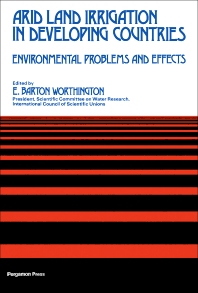Browse content
Table of contents
Actions for selected chapters
- Full text access
- Book chapterNo access
APPENDIX 1 - LIST OF PARTICIPANTS AT THE SYMPOSIUM
Pages 445-452 - Book chapterNo access
APPENDIX 2 - GLOSSARY OF ACRONYMS
Page 453 - Book chapterNo access
INDEX
Pages 455-463
About the book
Description
Arid Land Irrigation in Developing Countries: Environmental Problems and Effects covers the proceedings of the International Symposium on Arid Land Irrigation, held in Alexandria, Egypt on February 16-21 1976. This book is organized into eight sections encompassing 46 chapters. The opening section deals first with the benefits of arid land irrigation and the effective use of water in irrigated agriculture. This section also tackles the public health and socio-economic impacts of irrigation, as well as the planning and managing of irrigation and drainage systems. The next section discusses the results of some case studies on arid land irrigation, such as in districts in Mexico, Iran, and Egypt. Other sections explore the influence of irrigation on changes in hydrological processes and cycle, soil fertility, water quality, and biological balances. The closing sections consider the human problems in irrigation areas, with an emphasis on the problem of schistosomiasis and malaria. These sections also look into the viewpoints of specialist agencies of the United Nations on arid land irrigation. This book will be of value to agriculturists, economists, and researchers.
Arid Land Irrigation in Developing Countries: Environmental Problems and Effects covers the proceedings of the International Symposium on Arid Land Irrigation, held in Alexandria, Egypt on February 16-21 1976. This book is organized into eight sections encompassing 46 chapters. The opening section deals first with the benefits of arid land irrigation and the effective use of water in irrigated agriculture. This section also tackles the public health and socio-economic impacts of irrigation, as well as the planning and managing of irrigation and drainage systems. The next section discusses the results of some case studies on arid land irrigation, such as in districts in Mexico, Iran, and Egypt. Other sections explore the influence of irrigation on changes in hydrological processes and cycle, soil fertility, water quality, and biological balances. The closing sections consider the human problems in irrigation areas, with an emphasis on the problem of schistosomiasis and malaria. These sections also look into the viewpoints of specialist agencies of the United Nations on arid land irrigation. This book will be of value to agriculturists, economists, and researchers.
Details
ISBN
978-0-08-021588-4
Language
English
Published
1977
Copyright
Copyright © 1977 Elsevier Ltd. All rights reserved.
Imprint
Pergamon
